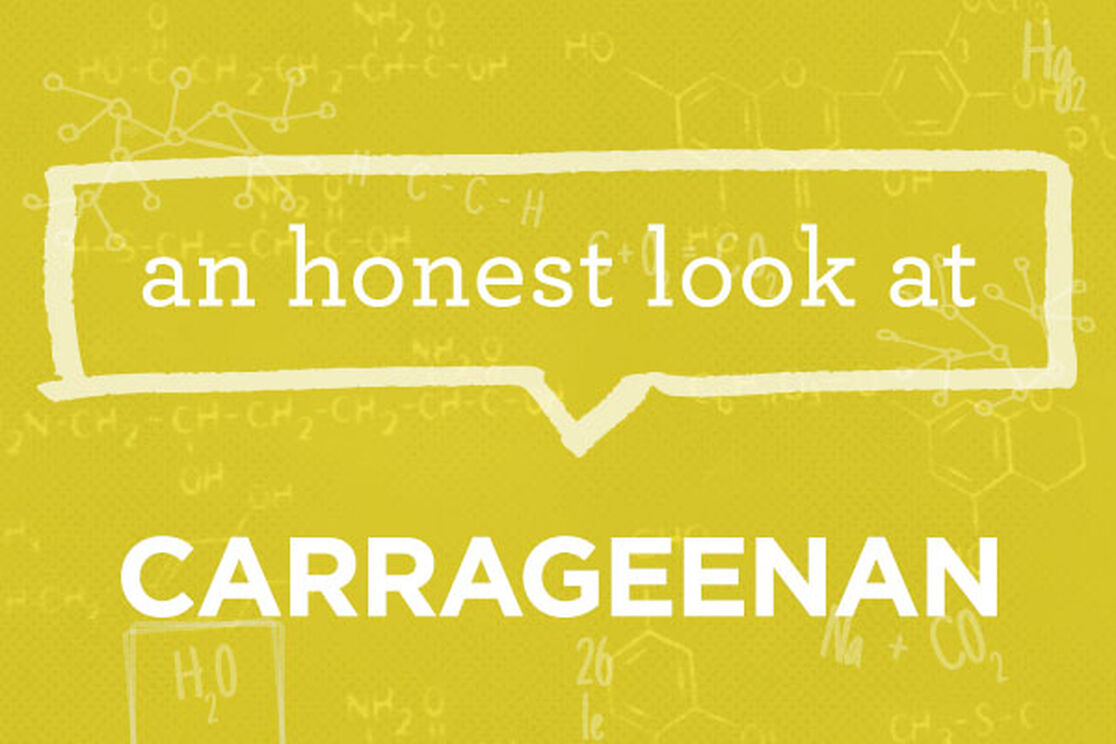This is part of our ongoing series helping consumers better understand chemicals, chemistry, and product formulations. We translate the science, bust the myths, and give you an honest assessment, so you can make informed choices for your family!
Ingredient:
Carrageenan
What it is:
Carrageenan is a fiber derived from red seaweed (1).
Note: Carrageenan is not poligeenan. Here’s the difference:
- Carrageenan (aka “native” carrageenan or “food-grade” carrageenan) is extracted from seaweed using a hot water process (1). It’s molecular weight averages 200,000 to 400,000 daltons (2). It’s been repeatedly tested and reviewed over decades and consistently deemed safe by agencies such as the U.S. Food and Drug Administration, the E.U. Scientific Committee on Food, and the United Nation’s Food and Agriculture Organization (FAO) and World Health Organization (2-13). In 2014, the Joint FAO/World Health Organization Expert Committee on Food Additives (JECFA) concluded that even the use of carrageenan in infant formula posed no concern (7). It was their seventh time since 1970 assessing the full body of research on carrageenan and they felt it’s safe as a food additive for those most vulnerable – babies (7).
- Poligeenan (aka “degraded” carrageenan) starts as carrageenan, but it undergoes an aggressive chemical process using strong acids and high temperatures over an extended period of time (14). It’s molecular weight is only 20,000 daltons (so it’s a much smaller molecule) (14). It does not have the same thickening properties as carrageenan, and its sole use today is as a component of an X-ray imaging diagnostic product (not food or cosmetics) (14). Poligeenan is possibly carcinogenic according to the International Agency for Research on Cancer and it’s also been linked to inflammatory bowel disease (15,16).
For many decades, poligeenan was referred to as “degraded carrageenan” causing some confusion among people over whether carrageenan has the same toxicity issues (14). In 1988, the US Adopted Names Council re-named “degraded carrageenan” as poligeenan to more clearly distinguish that they are two separate chemicals (17). Still, some confusion persists.
What it does:
Carrageenan is a thickener and stabilizer that’s been around for centuries (1). The red seaweed and its extract have been used in foods and home remedies in Ireland since 400 A.D. and it’s been made commercially since the 1930s (1,12). Currently, it’s used in foods, pharmaceuticals, cosmetics, and more (12).
Why we use it:
We use carrageenan in our Honest Toothpaste and Honest Kid’s Toothpaste to help give them a thick, smooth texture. We love that it’s a plant-derived, renewable resource and, as mentioned above, has a long, long history of safe use.
References:
- Food and Agriculture Organization of the United Nations. (n.d). Training manual on Gracilaria culture and seaweed processing in China. Retrieved January 11, 2016, from http://www.fao.org/docrep/field/003/AB730E/AB730E03.htm
- Weiner, M. L. (1991). Toxicological properties of carrageenan. Agents and actions, 32(1-2), 46-51.
- CFR - Code of Federal Regulations Title 21. (n.d.). Retrieved January 11, 2016, from http://www.accessdata.fda.gov/scripts/cdrh/cfdocs/cfCFR/CFRSearch.cfm?CFRPart=172
- European Commission Scientific Committee on Food. (2003). Opinion of the Scientific Committee on Food on Carrageenan. Retrieved January 11, 2016, from http://ec.europa.eu/food/fs/sc/scf/out164_en.pdf
- Cohen, S. M., & Ito, N. (2002). A critical review of the toxicological effects of carrageenan and processed eucheuma seaweed on the gastrointestinal tract. CRC Critical Reviews in Toxicology, 32(5), 413-444.
- Joint FAO/WHO Expert Committee on Food Additives. (2015). Safety evaluation of certain food additives. Retrieved January 11, 2016, from http://apps.who.int/iris/bitstream/10665/171781/3/9789240693982_eng.pdf?ua=1
- World Health Organization. Joint FAO/WHO Expert Committee on Food Additives. Seventy-ninth meeting. Geneva, 17-26 June 2014. Summary and Conclusions. Carrageenan for use in infant formula and formula for special medical purposes intended for infants. http://www.fao.org.
- Rustia, M., Shubik, P., & Patil, K. (1980). Lifespan carcinogenicity tests with native carrageenan in rats and hamsters. Cancer letters, 11(1), 1-10.
- McGill, H. C., McMahan, C. A., Wigodsky, H. S., & Sprinz, H. (1977). Carrageenan in formula and infant baboon development. Gastroenterology,73(3), 512-517.
- Ariffin, S. H. Z., Wong, W. Y., Abidin, I. Z. Z., Wahab, R. M. A., Ariffin, Z. Z., & Senafi, S. (2014). Cytotoxicity effect of degraded and undegraded kappa and iota carrageenan in human intestine and liver cell lines. BMC complementary and alternative medicine, 14(1), 508.
- Weiner, M. L., Nuber, D., Blakemore, W. R., Harriman, J. F., & Cohen, S. M. (2007). A 90-day dietary study on kappa carrageenan with emphasis on the gastrointestinal tract. Food and chemical toxicology, 45(1), 98-106.
- Necas, J., & Bartosikova, L. (2013). Carrageenan: a review. Veterinarni Medicina, 58(4), 187-205.
- Hagiwara, A., Miyashita, K., Nakanishi, T., Sano, M., Tamano, S., Asai, I., ... & Shirai, T. (2001). Lack of Tumor Promoting Effects of Carrageenan on 1, 2-Dimethylhydrazine-induced Colorectal Carcinogenesis in Male F344 Rats.Journal of Toxicologic Pathology, 14(1), 37-43.
- Borowitzka, M., Critchley, A. T., Kraan, S., Peters, A., Sjøtun, K., & Notoya, M. (Eds.). (2009). Nineteenth International Seaweed Symposium: Proceedings of the 19th International Seaweed Symposium, held in Kobe, Japan, 26-31 March, 2007 (Vol. 2). Springer Science & Business Media.
- International Agency for Research on Cancer. (n.d.). Agents Classified by the IARC Monographs, Volumes 1–112. Retrieved January 11, 2016, from http://monographs.iarc.fr/ENG/Classification/ClassificationsAlphaOrder.pdf
- Tytgat, G., Bartelsman, J. F. W. M., & van Deventer, S. J. H. (1995). Inflammatory Bowel Diseases (No. 85). Springer Science & Business Media.
- Council, U. S. A. N. (1988). List no. 297 new names, poligeenan. Clin Pharmacol Therapeut, 44, 246-8.
We aim to provide you with the most honest and credible information possible. This article was reviewed for accuracy by The Honest Team and was written based on sources that are linked at the bottom of the article.
blog_review_statement



